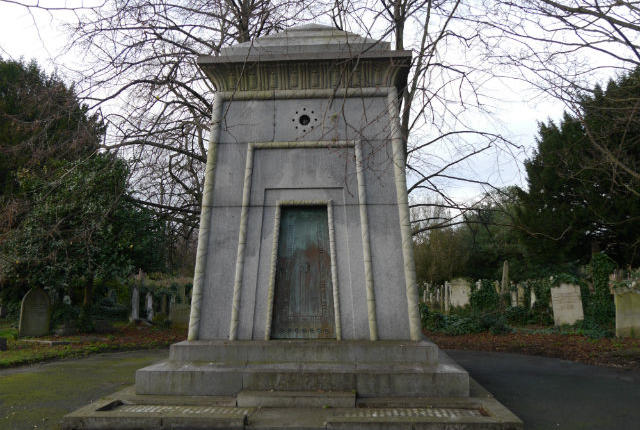
Swinging open the front gate of Brompton Cemetery is a bit like cracking the spine of a book detailing London history. Famous suffragist Emmeline Pankhurst rests here. Beatrix Potter strolled its 39 acres and plucked names from tombstones to use in her work, including decedents Peter Rabbett and Mr.
Nutkins. More than 35,000 monuments in all are present, rich and poor, known and obscure.In the middle of the grounds and shrouded by trees stands a mausoleum. An imposing 20 feet tall with a pyramid peak, it’s made from granite, with a heavy bronze door secured by a keyhole. Decorative accents line the front, furthering the air of mystery. The door’s margin displays a rectangular band of Egyptian hieroglyphs. Erected in the early 1850s, it was intended as the final resting place of a woman named Hannah Courtoy and two of her three daughters, Mary and Elizabeth.
Courtoy’s tomb would be remarkable for its imposing stature and cryptic veneer alone: It’s the largest, most elaborate construction in Brompton. But there’s more to the story. For the many visitors who make moonlight visits to the cemetery and for a small band of London raconteurs, the tomb’s missing key and resulting lack of access has led to speculation that something strange is going on inside—that it’s secretly a time machine.
It’s a fantastic notion, but one that London musician and Courtoy historian Stephen Coates is quick to dismiss. “It’s not a time machine,” he tells mental_floss. “It’s a teleportation chamber.”

In order to try and digest the bizarre urban legend that’s been constructed around Courtoy’s tomb, it helps to understand the highly controversial life of the woman who ordered its construction.
Born around 1784 (sources differ), Hannah Peters fled an abusive father at a young age and found work as a housekeeper and as a tavern employee. In 1800, a friend introduced her to John Courtoy, a 70-year-old former wigmaker in poor health who had made a fortune in the lending business. Peters was shortly in his employ as a housekeeper. Within the year, she had given birth to the first of three daughters. She claimed they were Courtoy’s, although some eyes were raised in suspicion that the friend who made the introduction, Francis Grosso, might have been the real father.
Courtoy’s illness is also ill-defined in historical accounts, although it was said to follow a violent run-in with a prostitute in 1795 that left Courtoy—who had been slashed at with a knife—reserved and antisocial. He apparently warmed to Peters, who took his name and exerted considerable influence over many of his decisions. Courtoy’s 1810 will, which left the bulk of his fortune to an ex-wife named Mary Ann Woolley and their five children, was revised in 1814 so Hannah received the majority share.
When Courtoy died in 1818, the contents of the will were disputed, both by Woolley and Courtoy’s French relatives; they argued that dementia had overtaken Courtoy’s better senses. The legal arguments dragged on through 1827, at which point Hannah and her daughters had received most of Courtoy’s money.
According to the account presented in author David Godson’s 2014 book Courtoy’s Complaint, largely based on diaries kept by Courtoy housekeeper Maureen Sayers, Hannah’s urge to distract herself from the often-unpleasant Courtoy led to developing a friendship that would prove essential to her later mythology. Like many Victorians of the era, Hannah was intrigued by Egyptian iconography, particularly hieroglyphics. She believed Egyptians had a deep understanding of astrology and their place in the universe, and she invited Egyptologist Joseph Bonomi over for regular visits.
Bonomi and Hannah would spend hours discussing Egyptian lore, with Hannah hoping to one day fund Bonomi’s expeditions to Egypt so he could study their work. The two would also arrange for a 175-foot-tall monument dedicated to the Duke of Wellington to be constructed and insisted that the sculpture resemble an Egyptian obelisk.
When Hannah died in 1849, her remains were set to be placed in an expensive, elaborate mausoleum in Brompton that paid tribute to her interests; Bonomi arranged for the tomb to feature Egyptian characters and a pyramidal top. Later, Mary and Elizabeth, who shied from marriage because they didn’t want men chasing after their wealth, joined her. (Susannah, who married, was buried elsewhere.) When Bonomi died in 1878, he arranged for a depiction of Courtoy’s tomb to appear on his own modest headstone. Whether Bonomi intended it or not, an illustration of Anubis, the Egyptian god of the dead, appears to be “looking” in the direction of his friend’s final resting place.
Things appeared to remain status quo at Brompton for the next 100 years or so. Then, around 1980, the key to the tomb was lost following a visit by Hannah’s relatives. And that’s when things took a turn for the weird.

The post The Legend of London’s Time-Traveling Tomb appeared first on FeedBox.